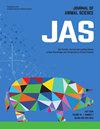108 Economic performance of stocker cattle grazing wheat pasture supplemented with distiller’s grains compared to varied nitrogen fertilizer rates
IF 2.7
2区 农林科学
Q1 AGRICULTURE, DAIRY & ANIMAL SCIENCE
引用次数: 0
Abstract
With increased costs of nitrogen (N) fertilizer, other N delivery routes may be utilized to capitalize on price differences to improve economic performance of stocker cattle grazing winter wheat. The objectives of this study were to observe how dried distiller’s grains plus solubles (DDGS) supplementation and varied N fertilization rates impacted steer, stand, and economic performance. From fall 2021 to spring 2024, 725 beef steers weighing 267.41 ± 40.25 kg were grazed at the Livestock and Forestry Station near Batesville, AR, with 24, 1.62-ha pastures established using no-till methods and planted the first week of September. Nitrogen was applied as split applications of 50% at fall planting, and 50% prior to spring greenup. Steers were weighed on arrival, turnout, every 28 days following turnout, and when removed from pasture. Steers were removed from pasture when temperatures became too cold for regrowth to occur, or when forage turned reproductive. Steers were stocked at rates of 2.47 and 4.94 hd/ha in the fall and spring, respectively. During the spring of year 3, blood urea nitrogen (BUN) was measured at day 0 and day 28 of grazing. Sample dates for forage mass and quality coincide with weigh dates. Treatments consisted of 3 yearly application rates of N along with an additional treatment at the lowest N rate supplemented with DDGS. Treatments were: 100N, 135N, 168N, and 100S. Pairwise comparisons within the Mixed Model procedure in JMP were used to compare treatment responses between N rates, with year as a random effect and N rate as a fixed effect. The only difference observed between unsupplemented N rates was an increase (P < 0.05) in spring grazing days for 168N and 135N. The Mixed Model procedure followed by a Dunnett’s test was used to compare N rates against DDGS supplementation with 100S set as the positive control, with year set as a random effect. Neither animal nor economic performance improved with supplementation in the fall. During the spring, DDGS supplementation resulted in greater (P < 0.05) number of grazing days, final forage mass, weight gain/ha, average daily gain (ADG), D28 BUN, combined grazing days, and greater (P < 0.05) combined weight gain/ha and total spring income compared to all unsupplemented treatments. While 100S improved spring animal performance, 100S had the greatest (P < 0.01) calf management and feeding costs, resulting in overall decreased (P < 0.01) net returns. Supplementation was determined to become economically favorable if pasture size was increased beyond what was possible during this study since increased forage accumulation would allow for greater stocking rates. While DDGS supplementation improved overall steer and stand performance during the spring, increased costs associated with supplementation hindered overall economic performance within the studied conditions.不同氮肥施用量对小麦牧场放牧牛的经济效益的影响
随着氮肥成本的增加,可以利用其他氮肥输送途径利用价格差异来提高放牧牛放牧冬小麦的经济效益。本研究的目的是观察添加干酒糟及可溶物(DDGS)和不同施氮量对阉牛、林分和经济性能的影响。从2021年秋季到2024年春季,在阿拉斯加州贝茨维尔附近的畜牧和林业站放牧了725头牛,体重为267.41±40.25 kg,采用免耕方法建立了24,1.62公顷的牧场,并在9月的第一周种植。氮肥在秋季播种时分两次施用,分别为50%和50%。在牛到达时、出栏时、出栏后每28天以及离开牧场时称重。当温度太低而无法再生时,或者当饲料变成繁殖饲料时,牛就会被赶出牧场。耕牛秋季和春季的放养率分别为2.47和4.94 hd/ha。第3年春季,分别于放牧第0天和第28天测定血尿素氮(BUN)。饲料质量和质量的样品日期与称重日期一致。处理包括3年施氮量外加最低施氮量加DDGS处理。处理分别为100N、135N、168N和100S。使用JMP混合模型程序中的两两比较来比较不同N率的处理反应,其中年份为随机效应,N率为固定效应。在未补充氮的情况下观察到的唯一差异是增加了(P <;在168N和135N条件下,春季放牧日数为0.05)。采用混合模型法和Dunnett试验,以1000s组为阳性对照,年份组为随机效应,比较DDGS与N率的差异。在秋季补充饲料后,动物生产性能和经济性能都没有改善。在春季,添加DDGS导致(P <;0.05)放牧日数、末料质量、增重/公顷、平均日增重(ADG)、D28 BUN、联合放牧日数,且大于(P <;与所有未添加的处理相比,复合增重/公顷和春季总收入。100S提高了春季动物生产性能,其中100S的P &;lt;0.01)犊牛管理和饲养成本,导致整体降低(P <;净收益0.01)。在本研究中,如果牧场规模增加到可能的范围之外,则确定补充在经济上是有利的,因为增加的牧草积累将允许更高的放养率。虽然添加DDGS可以改善春季的整体转向和林分性能,但在研究条件下,添加DDGS相关的成本增加阻碍了整体经济性能。
本文章由计算机程序翻译,如有差异,请以英文原文为准。
求助全文
约1分钟内获得全文
求助全文
来源期刊

Journal of animal science
农林科学-奶制品与动物科学
CiteScore
4.80
自引率
12.10%
发文量
1589
审稿时长
3 months
期刊介绍:
The Journal of Animal Science (JAS) is the premier journal for animal science and serves as the leading source of new knowledge and perspective in this area. JAS publishes more than 500 fully reviewed research articles, invited reviews, technical notes, and letters to the editor each year.
Articles published in JAS encompass a broad range of research topics in animal production and fundamental aspects of genetics, nutrition, physiology, and preparation and utilization of animal products. Articles typically report research with beef cattle, companion animals, goats, horses, pigs, and sheep; however, studies involving other farm animals, aquatic and wildlife species, and laboratory animal species that address fundamental questions related to livestock and companion animal biology will be considered for publication.
 求助内容:
求助内容: 应助结果提醒方式:
应助结果提醒方式:


